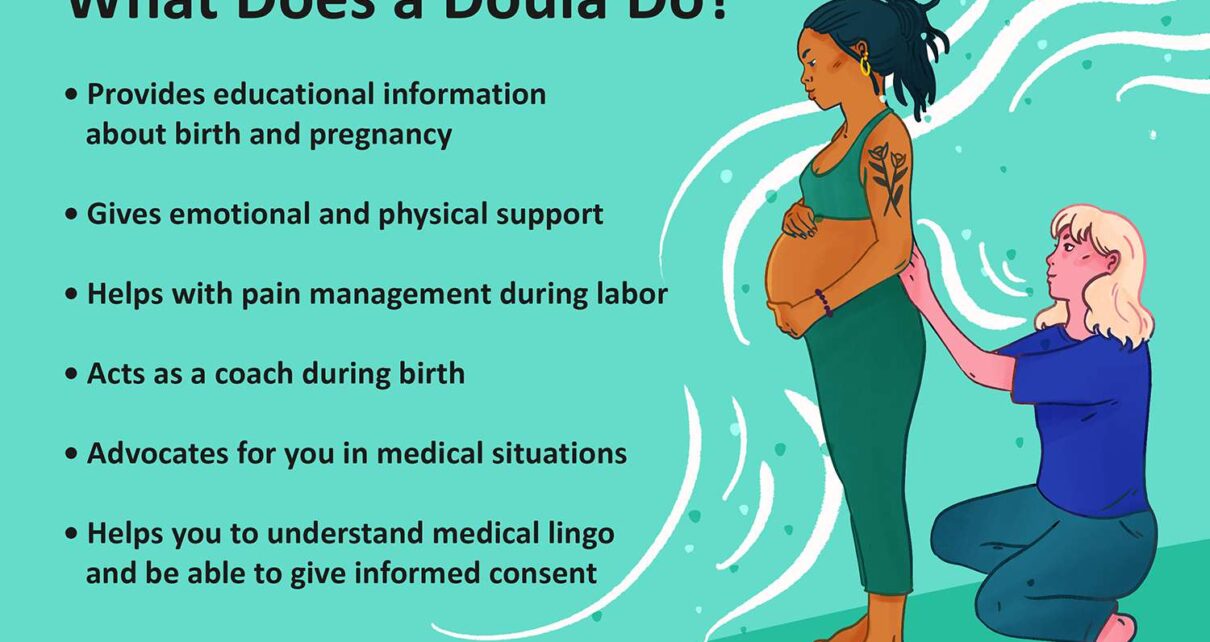How doulas could help prevent the harms that can happen during childbirth
By Candace Y.A. Montague

When Tamiya Griffin was expecting her first child in 2014, she had what she thought was a straightforward plan: deliver at the hospital down the road, the same place her mother gave birth to her. But when Griffin, then a 22-year-old senior in college, went into labor a few weeks early, she had to undergo an emergency C-section. “And that was not a part of my plan. We never talked about that. I didn’t even think about a C-section. I wasn’t prepared for that,” said Griffin.
When she became pregnant the second time, Griffin went back to the same practice. But this time, there was a disconnect: her providers wanted to do another C-section by default, and Griffin wanted to try to deliver vaginally. They still weren’t on the same page when she went into labor early again.
Her dilation stalled around three centimeters, just as it had done during her first delivery, and her labor was not progressing. She said she wasn’t offered any medication to advance the labor or to numb the pain. She was the one having the baby — but it felt to her like the staff held all the power, with little room for discussion. “They seemed to have in their minds that I was going to have a C-section.” Tired, disappointed, and miserable, she acquiesced. Looking back, she felt she’d been robbed of her autonomy.
Griffin’s experience reflects an issue long raised by patients, and increasingly recognized by leading health organizations: widespread harm can happen during childbirth. That harm is sometimes called obstetric violence, a phrase coined by activists in Argentina in the early 2000s to describe the injustices suffered by people giving birth in clinical settings. The umbrella term covers a wide range of actions — from unnecessary episiotomies and exams performed without consent to dehumanizing or dismissive language — that can happen during pregnancy, delivery, or in the post-partum period.
“The healthcare system is not always meant to protect or make people’s health status better. It can do harm,” said Candace Martin, a New Jersey nurse and perinatal health equity advocate who has also worked in birthing centers and hospitals in Nicaragua and Uganda.
But doulas, midwives, and other birth workers — whose chief job is to ensure that both the parent and infant are safe and healthy during delivery — can help mitigate those harms by serving as a trusted liaison between doctors and patients.
With maternity care ‘deserts’ in the U.S. leaving some seven million people with limited access to maternity care during pregnancy, the need for birth workers has never been more urgent. Because of a lack of uniform certification standards, it’s difficult to tally the number of such birth workers in the U.S., but their work is garnering increased investment. In April 2022, the federal health department announced $4.5 million in new grants to hire, train, certify, and pay community-based doulas.
The administration is investing in doulas as part of its effort to reduce maternal mortality and other severe complications, which take a particularly high toll on Black people during pregnancy. Those complications are partly driven by decades of racial and gender bias in obstetric care, and have created a wall of mistrust between some medical professionals and the pregnant patients they see. Black women, in particular, have complained for decades about being ignored by physicians. This kind of disregard can have fatal results.
Birth workers have a powerful role to play in rebuilding that trust — and in turn, hopefully preventing harm during pregnancy and childbirth.
Martin and other birth workers said they’ve seen that kind of harm manifest in myriad ways: pregnant people being pressured to have a C-section out of convenience, providers performing exams or procedures like membrane sweeps without consent, patients being coerced or deceived about their treatment options at crisis pregnancy centers, or in some cases, patients being threatened with a call to social services if they don’t agree to a particular course of care.
One 2016 survey of 2,700 women who gave birth in California or New York found that people of color were twice as likely to report feeling pressured into medical interventions after declining them at first. The most common non-consensual procedure reported by people of color in the study was an injection to assist delivery of the placenta. More than 20% of respondents felt that their preferences were not respected, with Black and Indigenous people more likely to report that they felt disrespected.
For Griffin, the harm came, in part, from the tactics her providers used to push her toward a C-section. She wanted to have what’s known as a VBAC, or vaginal birth after a C-section. Medical groups consider trying for a vaginal birth after a first C-section, as Griffin was doing, generally safe for many patients. After more than two C-sections, the chances of success decline and the risk of complications rises.
“When I brought up the idea that I wanted to try vaginal birth, the providers tried scare tactics,” she said. Griffin said that all she heard were horror stories of failed VBACs, and wasn’t told about how those risks compared to the odds of a successful vaginal birth. She started second-guessing her choice: What if she didn’t make it?
By her next pregnancy, Griffin had trained to become a doula herself. “It wasn’t until I was pregnant with my second son that I even learned doulas existed. At that time I realized a doula was exactly what I could have benefited from and from there I decided to become one,” she said.
After being counseled by her provider, she was able to safely deliver vaginally in 2019, with her own doula and family members by her side.
For patients, feeling heard by a health care provider is critical. When Jessica Dawson found out she was pregnant at age 22, both she and her child’s father were elated. Then Dawson, an African American woman, started hemorrhaging and experiencing contractions in the first trimester. She was devastated to learn her pregnancy was no longer viable. But what came after compounded her grief.
“[My doctor] took the time to lecture me and my child’s father about how having unprotected sex leads to pregnancies. He began saying things like ‘c’mon guys, you have your whole lives, make sure that you don’t end up in this situation again,’” she recalled. It was a deeply disrespectful remark in a moment of heartbreaking loss. “I informed him that I did not appreciate his condescending tone, and that his lesson in unplanned pregnancies was unnecessary,” she said.
Dawson, now the mother of a seven-year-old son, sought a new provider for her second pregnancy. “All of my experiences prompted me to be very intentional about changing my provider for my next pregnancy. I wanted to be sure I had someone who was kind, patient, and thoughtful; and preferably a woman. And my next OB was all of those things.”
When people feel their wishes or needs are being ignored during delivery, doulas, midwives, and other birth workers can be on standby to give support. They can share advice about how to proceed when a birth plan is complicated by the unexpected, offer a more personal level of support between clinician check-ins, or advocate when someone’s symptoms aren’t being treated seriously enough.
“Not everyone who goes into a delivery room understands what’s happening. And you trust the people who are in there to make the best decisions for you,” said Erin Clark, a doula based in Washington, D.C. “Some people go in the delivery room alone and they are susceptible to doctors doing whatever they want. Those people need doulas,” she added.
Clark and other experts said it’s critical for patients to be fully informed of their options at every step of the process.
“Patients need to ask questions and ask for help. They are allowed to ask for more information. If they feel like something is not right, they should trust their gut. If they want to ask for another doctor or speak to a supervisor, they should be empowered to do so,” said Meika Neblett, an emergency physician and the chief medical officer of Community Medical Center, a facility of RWJ Barnabas Health in New Jersey.
Neblett said as a guiding principle, doctors and patients should always be making decisions together, whether or not a doula or another advocate is there. She acknowledged that even with good intentions, patients, doctors, and advocates can sometimes clash when things begin to get intense in the delivery room. Doulas are on the side of the patient, and while some doctors might welcome their presences, others sometimes make it clear to doulas that they feel like they are in the way. In every case, both sides want to see a safe delivery without complications. In the best-case scenario, how that works can look like Griffin’s third delivery.
During pregnancy, Griffin met with both a provider and her doula to discuss her birth plan. Having everyone on the same page before the birth made for a smoother ride on the third go around. While her doctor might have come in and out during delivery, her doula was dedicated just to her.
Neblett cautioned that having advocates in the delivery room will only work when each person attending the birth listens with care. “There needs to be mutual respect for each other’s opinions and what each person is fighting for at that moment,” she said. “We cannot be in a battle where everyone is saying ‘you’re not listening to me’ —‘no, you’re not listening to me.’”
This story is part of ongoing coverage of reproductive health care supported by a grant from the Commonwealth Fund.







